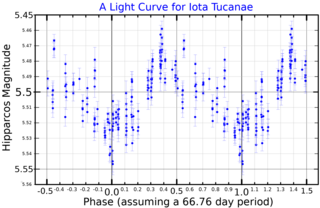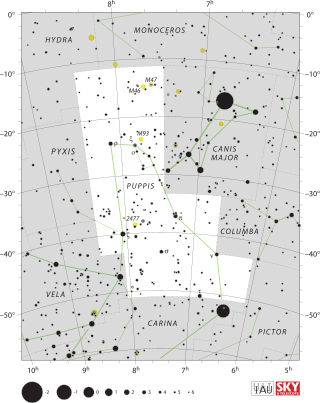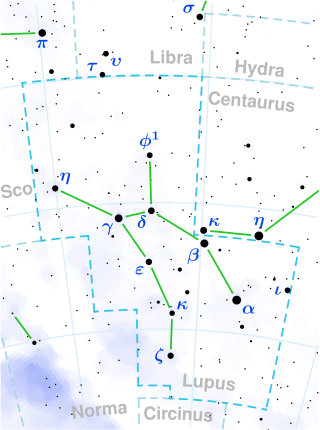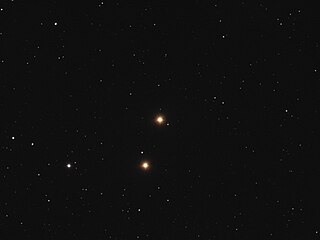
Kappa Trianguli Australis is a star in the constellation Triangulum Australe. It is a yellow G-type supergiant with an apparent magnitude of +5.08, making it visible to the naked eye under good observing conditions. It is around 1,200 light years from Earth.

Iota Tucanae is a solitary star in the southern constellation of Tucana. Based upon an annual parallax shift of 10.72 mas as seen from Earth, it is located around 304 light years from the Sun. With an apparent visual magnitude of +5.33, it is faintly visible to the naked eye.
23 Andromedae, abbreviated 23 And, is a presumed single star in the constellation Andromeda, although it has been a suspected spectroscopic binary. 23 Andromedae is the Flamsteed designation. Its apparent visual magnitude is 5.71, which indicates it is dimly visible to the naked eye under good viewing conditions. The distance to 23 And, as determined from its annual parallax shift of 26.8 mas, is 121.6 light years. The star is moving further from the Earth with a heliocentric radial velocity of −27 km/s. It has a relatively high proper motion, traversing the celestial sphere at the rate of 0.191″ per year.

28 Cancri is a star system in the zodiac constellation of Cancer. It is a variable star with the designation CX Cancri, and is close to the lower limit of visibility with the naked eye, having a mean apparent visual magnitude of 6.05. The annual parallax shift seen from Earth's orbit is 8.5 mas, which provides a distance estimate of about 384 light years. It is moving away from the Sun with a radial velocity of around +9 km/s.

50 Cassiopeiae is a white star in the northern constellation of Cassiopeia. In the past, it had been misidentified as a suspected nebula, and given the number NGC 771. The star is visible to the naked eye, having an apparent visual magnitude of +3.95. Based upon an annual parallax shift of 20.76 mas, it is located 157 light years away. It is moving closer, having a heliocentric radial velocity of −18 km/s, and will approach to within 82 ly in 1.879 million years.

29 Vulpeculae is a suspected astrometric binary star system in the northern constellation Vulpecula. It is visible to the naked eye as a faint, white-hued point of light with an apparent visual magnitude of 4.82. The system lies approximately 209 light years away from the Sun based on parallax, and is a member of the IC 2391 supercluster. It is moving closer to the Earth with a heliocentric radial velocity of −17 km/s.

1 Camelopardalis is a double star system in the constellation Camelopardalis. Its combined apparent magnitude is 5.56 and it is approximately 800 parsecs (2,600 ly) away. It is faintly visible to the naked eye under good observing conditions.

Epsilon Pyxidis (ε Pyxidis) is quadruple star system in the southern constellation of Pyxis. It is faintly visible to the naked eye, having a combined apparent visual magnitude of +5.60. Based upon an annual parallax shift of 15.39 mas as seen from Earth, it is located around 212 light years from the Sun. The system is deemed to be a member of the Sirius supercluster of stars that share a common motion through space.

Kappa Pyxidis, Latinized from κ Pyxidis, is a single, orange-hued star in the southern constellation of Pyxis. It is visible to the naked eye as a faint point of light with an apparent visual magnitude of +4.62. The star is located approximately 520 light years from the Sun based on parallax, but is drifting closer with a radial velocity of −45 km/s and may come as close as 308 light-years in around 2.6 million years. It is moving through space at the rate of 53.7 km/s relative to the Sun and is following an orbit through the Milky Way galaxy with a large eccentricity of 0.68

Nu Puppis is a solitary, blue-hued star in the southern constellation of Puppis. It is the fifth-brightest star in Puppis, with an apparent visual magnitude of 3.17. Based upon an annual parallax shift of 8.78 mas as seen from Earth, it is located about 370 light years from the Sun. The system made its closest approach about 3.6 million years ago when it underwent perihelion passage at a distance of roughly 27 light years.

Sigma Cygni, Latinised from σ Cygni, is a blue supergiant star in the constellation Cygnus. Its apparent magnitude is 4.2. It belongs to the Cygnus OB4 stellar association and is located approximately 3,300 light years away from Earth.
HD 217382 is a suspected binary star system in the northern circumpolar constellation of Cepheus. It is faintly visible to the naked eye with an apparent visual magnitude of 4.70. The distance to HD 217382 is around 373 light years, as determined from an annual parallax shift of 8.74 mas. The system is moving further away with a heliocentric radial velocity of +2.6 km/s. It is a candidate member of the Hyades supercluster and has a peculiar velocity of 9.2 km/s.

64 Eridani is a single, yellow-white hued star in the constellation Eridanus having variable star designation S Eridani. It is faintly visible to the naked eye with an apparent visual magnitude of 4.77. The annual parallax shift is measured at 12.01 mas, which equates to a distance of about 272 light years. In addition to its proper motion, it is moving closer to the Sun with a radial velocity of around −9 km/s.
Mu Coronae Borealis, Latinized from μ Coronae Borealis, is a solitary, ruby-hued star located in the northern constellation of Corona Borealis. It is faintly visible to the naked eye, having an apparent visual magnitude of 5.12. Based upon an annual parallax shift of 5.27 mas, it is located roughly 620 light years from the Sun. This is an evolved red giant star with a stellar classification of M1.5 IIIb. It is currently on the asymptotic giant branch and is a variable star of uncertain type, showing a change in brightness with an amplitude of 0.0147 magnitude and a frequency of 0.02455 cycles per day, or 40.7 days/cycle. On average, it is radiating 932 times the Sun's luminosity from its enlarged photosphere at an effective temperature of 3,889 K.

Phi1 Lupi is a solitary star in the southern constellation of Lupus. It is visible to the naked eye with an apparent visual magnitude of 3.58. Based upon an annual parallax shift of 11.86 mas as seen from Earth, it is located around 275 light years from the Sun. The star is drifting closer with a radial velocity of −29 km/s. It has an absolute magnitude of −1.55.

Rho Lupi, Latinized from ρ Lupi, is a solitary star in the southern constellation of Lupus. It is visible to the naked eye with an apparent visual magnitude of 4.05. Based upon an annual parallax shift of 10.32 mas as seen from Earth, it is located about 316 light years from the Sun. It is a member of the Upper Centaurus–Lupus subgroup of the nearby Scorpius–Centaurus association.

17 Persei is a single star in the northern constellation of Perseus, located about 420 light years away from the Sun. It is visible to the naked eye as a faint, orange-hued star with an apparent visual magnitude of 4.53. This object is moving further from the Earth at a heliocentric radial velocity of +13 km/s.

N Scorpii, also known as HD 148703, is a solitary, bluish-white hued star located in the southern constellation Scorpius. It has an apparent magnitude of 4.23, making it readily visible to the naked eye. N Scorpii was initially given the Bayer designation Alpha Normae by Lacaille but it was later moved from Norma to Scorpius. N Scorpii is currently located 550 light years away based on parallax measurements from the Hipparcos satellite and is part of the Upper Scorpius–Centaurus region of the Scorpius–Centaurus association.

V1073 Scorpii is a variable star in the constellation Scorpius. It has a non-Greek Bayer designation of k Scorpii. The star has a blue-white hue and is visible to the naked eye with an apparent visual magnitude that fluctuates around +4.87. Parallax measurements yield a distance estimate of approximately 2,920 ly (896 pc) from the Sun, and it is drifting further away with a radial velocity of +7 km/s. It has an absolute magnitude of −6.8

Nu1 Coronae Borealis is a solitary, red-hued star located in the northern constellation of Corona Borealis. It is faintly visible to the naked eye, having an apparent visual magnitude of 5.20. Based upon an annual parallax shift of 5.02 mas, it is located roughly 650 light years from the Sun. At its distance, the visual magnitude is diminished by an extinction of 0.1 due to interstellar dust. This object is drifting closer with a radial velocity of −13 km/s.

















